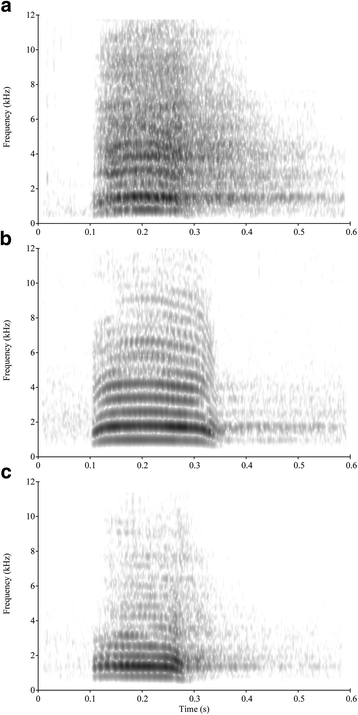Raven food calls indicate sender's age and sex
- PMID: 29563949
- PMCID: PMC5848575
- DOI: 10.1186/s12983-018-0255-z
Raven food calls indicate sender's age and sex
Abstract
Background: Acoustic parameters of animal signals have been shown to correlate with various phenotypic characteristics of the sender. These acoustic characteristics can be learned and categorized and thus are a basis for perceivers' recognition abilities. One of the most demanding capacities is individual recognition, achievable only after repeated interactions with the same individual. Still, class-level recognition might be potentially important to perceivers who have not previously encountered callers but can classify unknown individuals according to the already learned categories. Especially for species with high fission-fusion dynamics that repeatedly encounter unknown individuals it may be advantageous to develop class-level recognition. We tested whether frequency-, temporal-, and amplitude-related acoustic parameters of vocalizations emitted by ravens, a species showing high fission-fusion dynamics in non-breeder aggregations, are connected to phenotypic characteristics and thus have the potential for class-level recognition.
Results: The analysis of 418 food calls revealed that some components summarizing acoustic parameters were differentiated by age-classes and sex.
Conclusions: Together, the results provide evidence for the co-variation of vocal characteristics and respective sex and age categories, a prerequisite for class-level recognition in perceivers. Perceivers that are ignorant of the caller's identity can thus potentially recognize these class-level differences for decision-making processes in feeding contexts.
Keywords: Acoustic characteristics; Age; Bioacoustics; Call production; Corvid; Corvus corax; Food call; Raven; Sex; Vocalization.
Conflict of interest statement
All studies are in compliance with legal regulations. Austrian ministry granted animal keeping permission BMWFW-66.006/0011-WF/II/3b/2014 as well as animal testing BMWF-66.006/0009-II/3b/2012; BMWFW-66.006/0019-WF/II/3b/2014. All experiments adhere to the ethical guidelines for animal behaviour research from developed by the Association for the Study of Animal Behaviour.Not applicable.The authors declare that they have no competing interests.Springer Nature remains neutral with regard to jurisdictional claims in published maps and institutional affiliations.
Figures


Similar articles
-
With whom to dine? Ravens' responses to food-associated calls depend on individual characteristics of the caller.Anim Behav. 2015 Jan;99:33-42. doi: 10.1016/j.anbehav.2014.10.015. Anim Behav. 2015. PMID: 25598542 Free PMC article.
-
Calls during agonistic interactions vary with arousal and raise audience attention in ravens.Front Zool. 2017 Dec 21;14:57. doi: 10.1186/s12983-017-0244-7. eCollection 2017. Front Zool. 2017. PMID: 29299036 Free PMC article.
-
Craving Ravens: Individual 'haa' Call Rates at Feeding Sites as Cues to Personality and Levels of Fission-Fusion Dynamics?Anim Behav Cogn. 2014 Aug 1;1(3):265-280. doi: 10.12966/abc.08.04.2014. Anim Behav Cogn. 2014. PMID: 25984563 Free PMC article.
-
Call type signals caller goal: a new take on ultimate and proximate influences in vocal production.Biol Rev Camb Philos Soc. 2018 Nov;93(4):2071-2082. doi: 10.1111/brv.12437. Epub 2018 Jun 12. Biol Rev Camb Philos Soc. 2018. PMID: 29896860 Review.
-
Cannot see you but can hear you: vocal identity recognition in microbats.Dongwuxue Yanjiu. 2015 Sep 18;36(5):257-62. doi: 10.13918/j.issn.2095-8137.2015.5.257. Dongwuxue Yanjiu. 2015. PMID: 26452691 Free PMC article. Review.
Cited by
-
Social dynamics impact scolding behaviour in captive groups of common ravens (Corvus corax).Front Zool. 2022 Dec 12;19(1):32. doi: 10.1186/s12983-022-00477-6. Front Zool. 2022. PMID: 36503565 Free PMC article.
-
Why are ravens smart? Exploring the social intelligence hypothesis.J Ornithol. 2024;165(1):15-26. doi: 10.1007/s10336-023-02111-6. Epub 2023 Oct 4. J Ornithol. 2024. PMID: 38225936 Free PMC article. Review.
-
With whom to dine? Ravens' responses to food-associated calls depend on individual characteristics of the caller.Anim Behav. 2015 Jan;99:33-42. doi: 10.1016/j.anbehav.2014.10.015. Anim Behav. 2015. PMID: 25598542 Free PMC article.
-
Waste Disposal Sites as All-You-Can Eat Buffets for Carrion Crows (Corvus corone).Animals (Basel). 2019 May 4;9(5):215. doi: 10.3390/ani9050215. Animals (Basel). 2019. PMID: 31060242 Free PMC article.
-
What constitutes "social complexity" and "social intelligence" in birds? Lessons from ravens.Behav Ecol Sociobiol. 2019;73(1):12. doi: 10.1007/s00265-018-2607-2. Epub 2019 Jan 19. Behav Ecol Sociobiol. 2019. PMID: 30930524 Free PMC article. Review.
References
-
- Bradbury JW, Vehrencamp SL. Principles of animal communication. Sunderland: Sinauer Associates; 2011.
-
- Falls JB. Individual recognition by sounds in birds. Acoust Commun Birds. 1982;2:237–278.
-
- Trivers R. The evolution of reciprocal altruism. Q Rev Biol. 1971;46:35. doi: 10.1086/406755. - DOI
-
- Aureli F, Schaffner Colleen M, Boesch C, Bearder Simon K, Call J, Chapman Colin A, Connor R, Fiore Anthony D, Dunbar Robin IM, Henzi SP, et al. Fission-fusion dynamics: new research frameworks. Curr Anthropol. 2008;49:627–654.
LinkOut - more resources
Full Text Sources
Other Literature Sources
Miscellaneous

